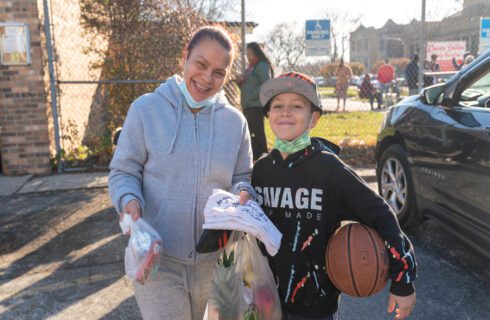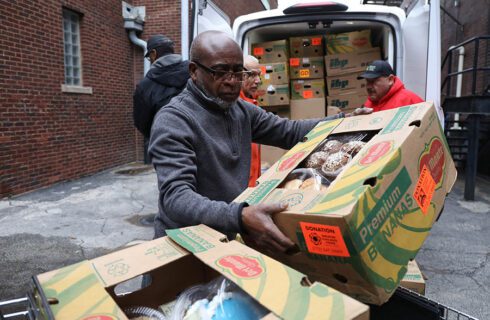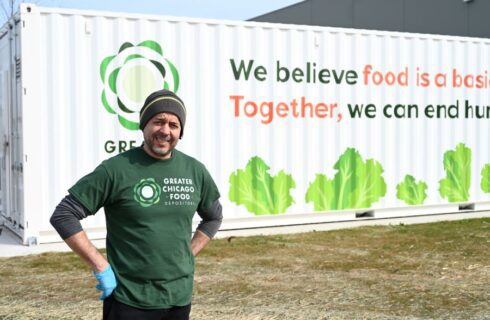The Food Depository's executive director and CEO, Kate Maehr, testified before a Joint Committee of City Council today. The hearing was held to discuss a resolution on food insecurity in Chicago introduced by Ald. Ameya Pawar. Below is the complete text of Kate's testimony:
Joint Committee Meeting of Chicago City Council
December 19, 2011
December 19, 2011
Committee on Health & Environmental Protection (Chairman George Cardenas)
Committee Economic, Capital & Technology Development (Chairman Tom Tunney)
Resolution introduced by Ald. Ameya Pawar
Committee Economic, Capital & Technology Development (Chairman Tom Tunney)
Resolution introduced by Ald. Ameya Pawar
Testimony by Kate Maehr, executive director and CEO, Greater Chicago Food Depository
Thank you to Alderman Pawar, Alderman Burke, Alderman Cardenas, Alderman Tunney and all aldermen who are present for making this conversation possible. I’m Kate Maehr, executive director and CEO of the Greater Chicago Food Depository, Chicago’s food bank. The mission of the Food Depository is to provide food for hungry people while striving to end hunger in our community. The Food Depository distributes donated and purchased food to a network of 650 pantries, soup kitchens and shelters in Cook County. Last year, the Food Depository distributed 69 million pounds of food. For 32 years, we have provided fresh, nutritious food to people in need in every neighborhood in Chicago.
I’d like to begin by sharing a story that is typical during these tough times. A few months ago, a single father of two, David, walked into a community center on the South Side. David didn’t know what to expect when he walked in; after all he only had heard about the Food Depository’s program at the center from a flyer. His work hours were recently cut, and he needed food to feed his two young children. Guided by a Food Depository outreach worker, David soon learned of the Supplemental Nutrition Assistance Program (SNAP, formerly the Food Stamp Program), and that he might be eligible for help. He also learned that there was a fresh source of free, wholesome food close to home, at a nearby Mobile Pantry stop. For David, the safety net worked beautifully.
This story illustrates how our web of supports can ensure that those who are hungry can have the food they need for them and their family. Unfortunately, the need right now is as high as it has ever been, and the safety net is not able to adequately meet that need.
The United States Department of Agriculture uses the term food insecurity to describe the lack of access to nutritious food in communities across the country. According to the USDA, people experiencing low food security report reduced quality, variety or desirability of diet. People experiencing very low food security, according to the USDA, report multiple indications of disrupted eating patterns and reduced food intake.
Earlier this year, the Food Depository worked with University of Illinois researcher Craig Gundersen and Feeding America, the nation’s network of food banks, to study food insecurity in each of Chicago’s 77 community areas. In September, we released data that shows that every community area in our city has individuals and families that are impacted. Lincoln Park, Lakeview, Austin, Ravenswood, South Shore, Norwood Park – all of these communities have need.
According to our analysis, one in five individuals in Chicago is experiencing food insecurity, meaning they are uncertain where their next meal may come from. This number translates into more than 580,000 residents of our city being vulnerable.
We are very pleased that the City of Chicago has recognized the importance of working towards ending hunger in both words and action, whether it is the City’s partnership on this year’s One City, One Food Drive, its regular support for emergency food provisions through the Department of Family and Support Services, the inclusion of access to affordable, healthy food in the Healthy Chicago plan, the establishment of Universal Breakfast in the Classroom in elementary schools or the focus on communities that currently have limited retail access to fresh foods.
We know that aldermen, including many of you in this room, are addressing hunger in your communities by holding food drives, working with community partners and volunteering to ensure that food is distributed to those in need. All of these efforts complement the Food Depository’s work to improve public health, and, ultimately, end hunger--distributing healthy foods to those who can least afford it, and working on fundamental solutions that help ensure no one is hungry in the first place.
We’re so pleased that food deserts have been a topic of conversation in Chicago in recent months. Food deserts are complex problems. The barriers to quality food are not only geographical, but also related to unemployment, low incomes and the expense of acquiring healthy food items. At the Food Depository, we’ve strengthened our commitment to distributing fruit and vegetables so that everyone in our community has access to fresh, healthy food, last year distributing more than 18 million pounds of fresh produce.
For example, in Austin, we distributed 552,000 pounds of produce as one response to the compounded effects of geography and limited income. In North Lawndale, we distributed 685,000 pounds of produce, in East Garfield Park, 522,000 pounds and in Englewood, 506,000 pounds.
Unfortunately, our task has been getting harder. While the number of individuals visiting food pantries has risen dramatically – more than 57 percent in the last three years – the food we need to feed those in need has only gotten more scarce. The latest U.S. Conference of Mayors report on Hunger and Homelessness, released last week, shows that not only Chicago but cities across the nation are struggling with these issues.
Global food prices are near an all-time high. With rising food prices, we have seen three compounding effects. First, a family’s budget is not stretching as far as it once did – whether that budget relies on earned income, SNAP, or , for a growing number of families, both. These factors require more people to visit a pantry. Second, federal commodities that we receive through The Emergency Food Assistance Program( or TEFAP) have diminished as prices have risen. Consequently, while federal funding level s for TEFAP have not gone down, we are receiving 40 to 50 percent less food from this program this year. Third, the dollars the Food Depository uses to purchase food do not stretch as far either, making it more difficult to fill the gap.
There are specific things that can be done by and in conjunction with the City Council and the city as a whole to address this problem:
Increase SNAP Outreach – SNAPprovides real resources that allow struggling families to buy food. The Food Depository has a team of staff that works every day to enroll households in the program. As the city works with retailers to open new stores in food deserts, a complementary SNAP Outreach effort should be put in place to ensure that the families that use the new store have the financial resources to do so.
Increase Food Rescue – When a food retailer has excess product that cannot be sold to the public, but is still useable, it should go to those in need. A number of Chicago’s food retailers already engage in food rescue efforts either with the Food Depository or directly with food pantries, but not all. Efforts should be made to bring others online to increase the food available through this resource.
Actively and vocally stand up for federal food programs – SNAP and other critical food and nutrition programs are regularly threatened by some members of Congress. ,The Farm Bill sets policy and funding for many of these programs, and it will be reauthorized in 2012. That process, unfortunately, can provide an opportunity for those that want to undermine the food and nutrition safety net. The City of Chicago should use its voice through the reauthorization process, and at other critical moments, to speak to the importance of these programs to the residents of our city and the need to protect and enhance them.
Leverage urban agriculture – As we expand opportunities for urban agriculture in Chicago, the city and other stakeholders should make a concerted effort to ensure that a portion of local produce is distributed to people who cannot afford to buy it.
By working on these specific action items, in conjunction with the myriad of existing efforts at both the community and city-wide level, we will end hunger in Chicago.
Thank you.
Submitted by
Kate Maehr
Share This Post



